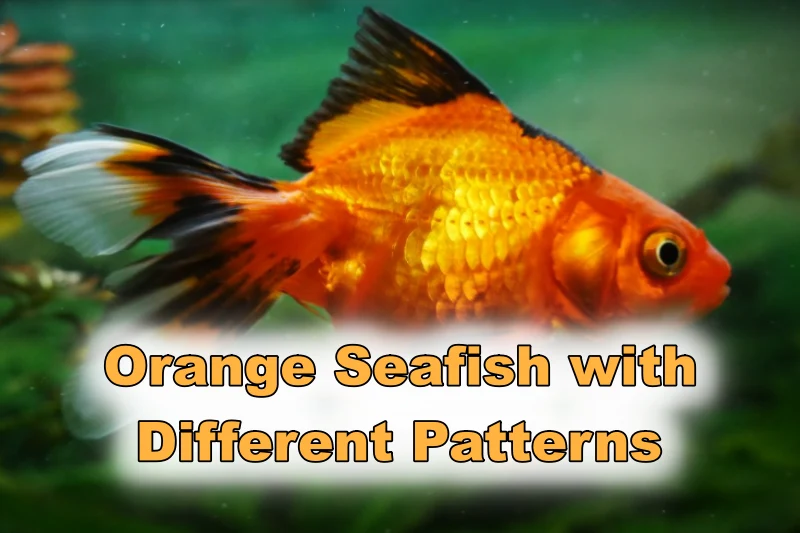As a child, the only complaint teachers had about me was the fact that I asked ‘way too many’ questions. As I grew up, my curiosity and inquisitiveness only grew stronger. This curiosity hasn’t just led me to discover new things but has also helped me maintain an open mind and a heart filled with intrigue.
In my quest to discover something new every day, I realized how desperately I needed companions for my four guppies, which were quietly swimming in one corner of my house.
Although my preferred color is black, I decided to opt for something more vibrant and lively. This decision led me to some of the most beautiful orange fish in the world.
Even though I searched through at least three different websites to find my favorites, I’ve curated a list of the 15 most beautiful and intriguing orange seafish with various patterns from all around the world. Now, you won’t have to mindlessly scroll through websites to discover them!
Join us on an exciting journey as we dive into the depths of the ocean to uncover the mysteries of the world.
Identify Orange Seafish with Different Patterns
1) Variatus Platyfish
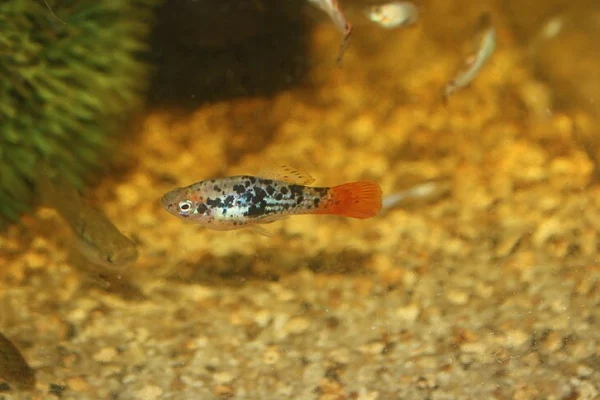
| Scientific name | Xiphophorus variatus |
| Diet | They are omnivores; hence their diet includes both plants and small animals like crustaceans, insects, and annelid worm |
| Size | <7 cm |
| Location | Northeastern Mexico |
These tiny yet breathtakingly beautiful fish have a vibrant orange body with striking black marbling or spots along the sides of its caudal peduncle.
These mesmerizing black spots create a mosaic-like pattern on the orange canvas.
Variatus Platy showcases a certain degree of sexual dimorphism in terms of its pattern and coloration.
The males of the species have blackish blotch on their dorsal fins.
The female orange platy fish exhibit a more triangular anal fin, distinguishing them from their male counterparts.
2) Clown loach
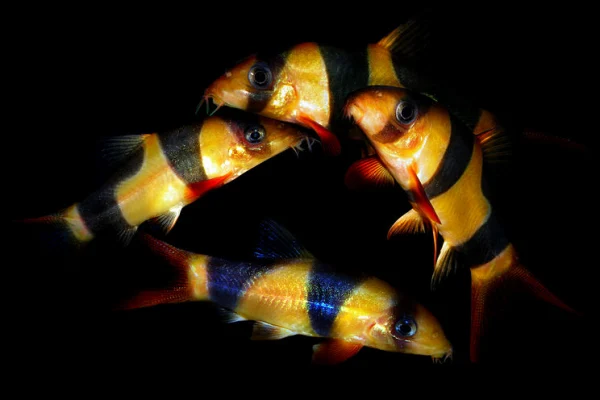
| Scientific name | Chromobotia macracanthus |
| Diet | They thrive on live foods: brine shrimp, small snails, worms, bananas, and other plant matters but can also survive on flake food and sinking pellets |
| Size | 15-30 cm |
| Location | Indonesia |
These elegant clown loaches are truly a gem to watch in your aquarium, with their beautifully blended orange body and black stripes they create a beautiful contrast.
These striking bands remind us of the bold stripes of a majestic tiger, earning it the nickname “tiger botia.”
But it would be foolishness to take their friendly and cheerful character for their weakness as tiger botia are known for their intriguing yet terrifying defense mechanism.
Clown loaches have a movable spine just below their eye that can be extended when needed.
This spine serves as both a warning and a form of protection, as it can inflict a painful wound against its predators.
3) Ocellaris clownfish
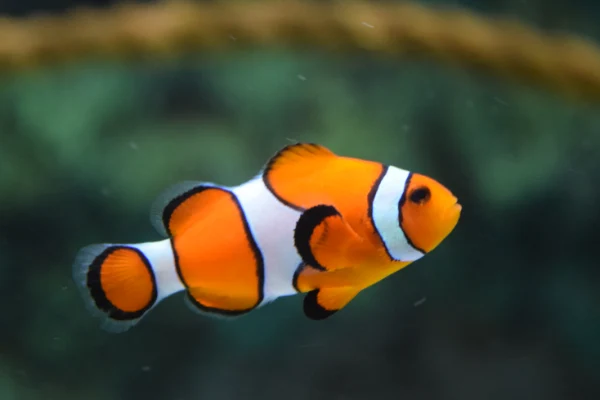
| Scientific name | Amphiprion ocellaris |
| Diet | Their diet mainly consists of algae and plankton |
| Size | up to 11 cm |
| Location | Australia, Southeast Asia, and Japan |
Did we just find Nemo? These beautiful clownfish are known for their vibrant orange body adorned with three distinct, pristine white bands.
These oval-shaped fish create a striking appearance reminding one of a clown’s cheerful costume when underwater.
Clownfish show variations depending on their geographic location.
Those found near northern Australia, Southeast Asia, and Japan showcase a brilliant black coloration with these classic white bands.
Clownfish have a laterally compressed rounded body and when seen in a school, they create a charming and approachable appearance.
4) Flame angelfish
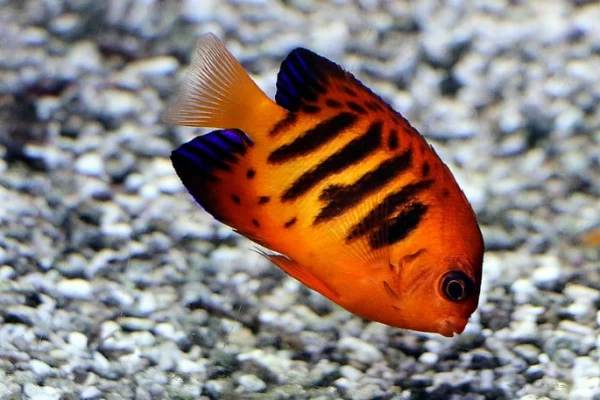
| Scientific name | Centropyge loricula |
| Diet | Includes crustaceans and algae |
| Size | up to 15.2 cm |
| Location | Pacific Ocean |
When you hear the word ‘flame,’ what often comes to mind is a bright orange, blazing fire. Interestingly, that’s also the color of our next fish in line!
Their fiery orange-colored body features a vertical elongated black spot that runs down its sides, adding a touch of contrast and elegance to its appearance.
Additionally, four or five bars, alternating between short purple–blue and black bands are present on the posterior part of its dorsal and anal fins.
Like many other creatures, the flame angelfish also showcases a certain degree of sexual dimorphism.
Males tend to be larger and display slightly more intense and vivid colors compared to their female counterparts.
5) Carpenter’s flasher wrasse
| Scientific name | Paracheilinus carpenter |
| Diet | Consists of a mix of both plants and small worms and animals |
| Size | <8 cm |
| Location | Pacific Ocean |
Known for its sunset-hued slender body, the Carpenter’s flasher wrasse comes in various colors showcasing its versatility in the underwater realm.
These not-so-tiny fish have an interesting way to attract their partners.
The males are known for “flashing” at the females by flaring their fins and intensifying the orange hue.
This flashing is accompanied by some moves and grooves that enhance their mating game.
In their natural habitat, Carpenter’s flasher wrasse is known to be friendly and poses no threat to other fish, invertebrates, or coral polyps.
6) Sea goldie
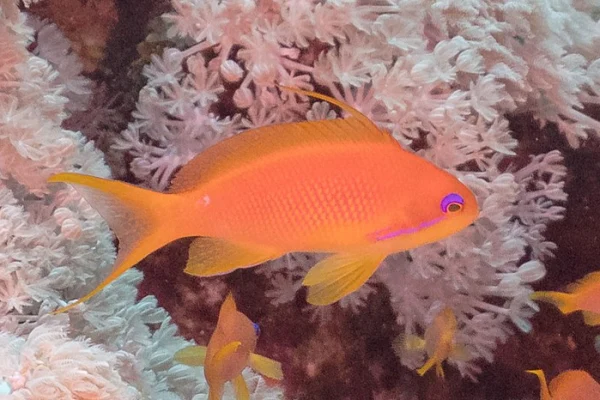
| Scientific name | Pseudanthias squamipinnis |
| Diet | It mainly feeds on zooplankton |
| Size | 7-15 cm |
| Location | Western Indian Ocean |
These sea jewels are one heck of an eye-catching species of fish.
With their vibrant orange and gold-colored bodies complemented by subtle violet streaks just below their eye, they never fail to capture a marine enthusiast’s attention!
Sea goldies have a certain degree of sexual dimorphism in terms of their size and color.
While the males grow up to 15 cm, the females in contrast are merely half their size.
They can be seen residing in coral outcrops, clear lagoons, patch reefs, and steep slopes up to depths of 35 meters in visually appealing schools.
Yet another fascinating feature is that in case of the male’s departure or demise, the largest and most dominant female undergoes remarkable hormonal and physical changes to transform into the new male.
This change can take several weeks to months for a complete transformation.
7) Harlequin tusk fish
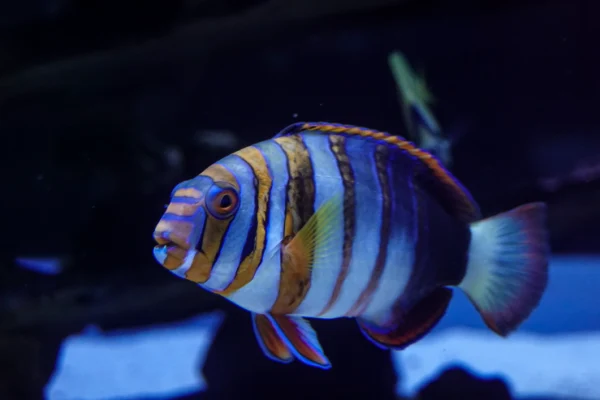
| Scientific name | Choerodon fasciatus |
| Diet | Brine shrimp, mysis, and shellfish in both live and frozen form |
| Size | 30 cm |
| Location | Western Pacific Ocean |
The Harlequin tusk is known for its vibrant blue, green, and orange coloration throughout its body.
This beautiful color palette of nature can grow up to a staggering length of 30 cm and with its distinctive blue teeth, they are here to steal the spotlight.
Its non-picky feeding behavior is said to have a prominent role in its distinct coloration and well-nourished appearance.
They are not the ideal choice as aquarium pets. When harlequins are young, they may be subjected to bullying, but as they mature, they become assertive and dominant.
This can make it challenging for fish enthusiasts to accommodate them with other species.
8) Copperband butterflyfish
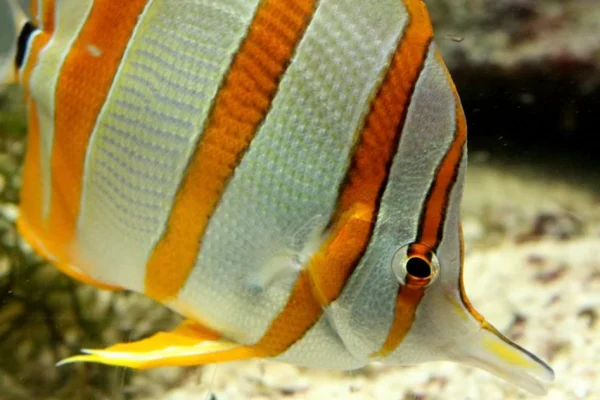
| Scientific name | Chelmon rostratus |
| Diet | They feed on all kinds of worms, clams, and mollusks |
| Size | 20 cm |
| Location | Pacific and Indian Oceans |
Found roaming around between coral reefs and rocky shorelines the copper band butterflyfish displays a beautiful combination of yellow, orange, and copper on its plain white body.
The copper band grows to a length of 20 centimeters but due to its slender stature, it appears longer.
Its distinct snout and vivid coloration make it stand out amongst the other marine species.
These species are monogamous and form pairs during the breeding season.
If you are planning to keep them as pets, make sure the tank volume is at least 75 gallons and the temperature ranges between 24 to 29 °C.
9) Coral grouper
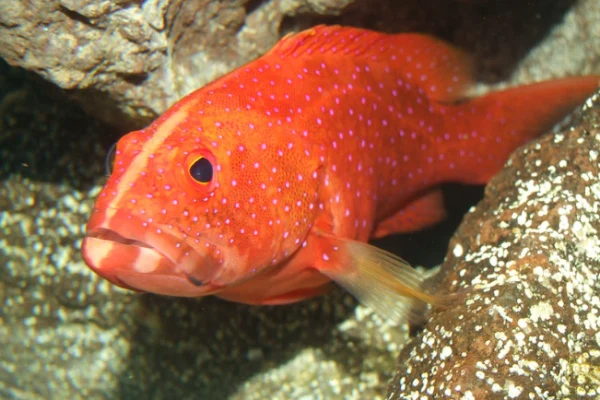
| Scientific name | Cephalopholis miniate |
| Diet | Small fishes, sometimes sea goldies as well, and crustaceans |
| Size | up to 50 cm |
| Location | Indo-Pacific regions |
Coral groupers are the rubies of the underwater world.
Their body showcases a beautiful amalgamation of orange-red coloration and numerous small, bright blue spots on its head, body, dorsal, anal, and caudal fins.
In its early stage, the coral grouper showcases orange to yellow with fewer, widely spaced faint blue spots.
As they mature, their color starts to brighten along with the blue spots turning darker and prominent.
10) Siamese fighting fish
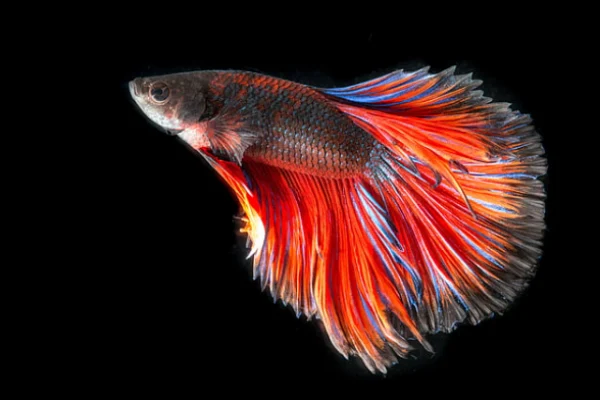
| Scientific name | Betta splendens |
| Diet | Zooplankton, crustaceans, larvae of insects, and algae |
| Size | 6-8 cm |
| Location | Southeast Asia |
While bettas are naturally green, brown, and grey, selectively bred Siamese fighting fish exhibit a stunning range of colors.
Orange-colored bettas stand out the most and are sought after by aquarium enthusiasts for their rich, warm hue creating an eye-catching and striking appearance.
The orange Siamese fighting fish have many small, contrasting dark spots or lines that create a mesmerizing contrast against the orange backdrop.
Unlike their wild counterparts, which display strong colors and aggressive tendencies primarily when agitated, these orange bettas are generally peaceful and timid.
11) Mandarin dragonet
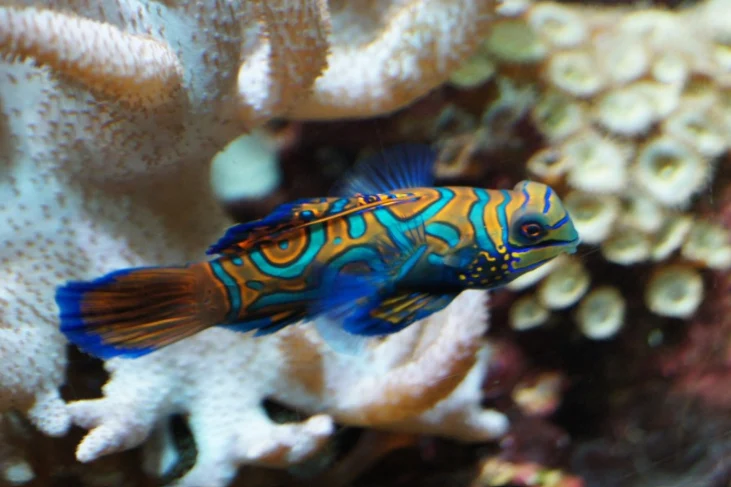
| Scientific name | Synchiropus splendidus |
| Diet | Fish eggs, worms, seed shrimps, and small crustaceans |
| Size | ~6 cm |
| Location | Pacific region extending to the south of Australia |
Straight out of a cartoon, this live explosion of color in the underwater world is here to capture everyone’s attention with its blue background graced with orange stripes.
It has large pelvic fins that not only give it an aesthetic appeal but are also used by it to ‘walk’ on the seabed.
Giving the mandarin dragonet an even more appealing look is their contrasting red eyes with dark pupils against their blue body.
They also possess a layer of smelly slime instead of scales, which helps them resist diseases and makes them unpalatable to their predators.
12) Orange-lined triggerfish
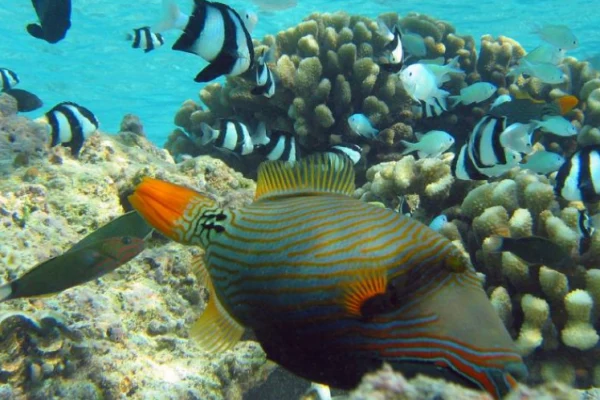
| Scientific name | Balistapus undulatus |
| Diet | Their diet includes small fish, crustaceans, algae, and mollusks |
| Size | <30 cm |
| Location | Indo-western Pacific |
If the name wasn’t a giveaway, allow me to formally introduce you to this mesmerizing oval-shaped fish, adorned with dark brown and green colors, accented by vibrant orange lines against an earthy-toned background.
Like the Mandarin dragonet, the orange-lined triggerfish is adorned with orange stripes on its dark green and blue body.
With their prominent head that comprises a whopping one-third of their body length, they stand out.
Their first dorsal fin has three spines, one of which is noticeably longer and sturdier, and usually tucked in when not in motion.
In its natural habitat, the orange-lined triggerfish thrives within coral reef ecosystems, coral lagoons, and external reef slopes.
13) Koi

| Scientific name | Cyprinus rubrofuscus var. “koi” |
| Diet | Crustaceans, small vertebrates, fish, and algae |
| Size | up to 90 cm |
| Location | Central Europe and Asia |
A symbol of love and friendship, koi is a widely bred species, valued not only for its cultural significance but also for its visual appeal.
While the most commonly seen koi is the orange and white one.
They are also known to exhibit an array of stunning colors, including white, black, red, yellow, blue, brown, and cream.
The interbreeding of this species has given rise to various new varieties, among which Kōhaku, Taishō Sanshoku, and Shōwa Sanshoku are the most sought-after.
14) Oscar
| Scientific name | Astronotus ocellatus |
| Diet | Sedentary catfish, shrimps, snails, insects, and their larvae, crayfish, and worms |
| Size | ~45 cm |
| Location | South America |
While the naturally occurring Oscar may not be the most ornamental fish in your aquarium, breeders have successfully enhanced their appearance, making them more appealing and aesthetic.
Juvenile Oscars have a white body adorned with orange wavy bands, complemented by intricately spotted heads.
They tend to be solitary species, preferring slow-moving white-water habitats, and often seek shelter beneath submerged branches.
But when it comes to defending themselves, Oscars are known for their territorial behavior in aquariums.
They often establish and fiercely defend their chosen territories.
15) Red devil cichlid
| Scientific name | Amphilophus labiatus |
| Diet | They mainly feed on shrimp, crickets, mealworms, and other small fish |
| Size | <38 cm |
| Location | Central America |
Despite the name suggesting a redfish, a red devil cichlid is more orangish-red against a dark background.
The naturally occurring cichlids are typically gray to grayish-green, although some may display striking pink, red, or even white hues.
If you plan to keep them with other fish in your aquarium, remember their aggressive nature, powerful jaws, and sharp teeth.
In certain parts of the world, it has gained a reputation for being an invasive species, especially in Lake Toba, where it poses a threat to native species.
Conclusion
This marks the end of yet another article about beautiful orange fish from around the world. Stay tuned because we have something new coming for you every day!
References
- https://en.wikipedia.org/wiki/Variable_platyfish
- https://en.wikipedia.org/wiki/Clown_loach
- https://en.wikipedia.org/wiki/Ocellaris_clownfish
- https://en.wikipedia.org/wiki/Flame_angelfish
- https://en.wikipedia.org/wiki/Carpenter%27s_flasher_wrasse
- https://en.wikipedia.org/wiki/Sea_goldie
- https://en.wikipedia.org/wiki/Harlequin_tuskfish
- https://en.wikipedia.org/wiki/Copperband_butterflyfish
- https://en.wikipedia.org/wiki/Coral_grouper
- https://en.wikipedia.org/wiki/Siamese_fighting_fish
- https://en.wikipedia.org/wiki/Synchiropus_splendidus
- https://en.wikipedia.org/wiki/Orange-lined_triggerfish
- https://en.wikipedia.org/wiki/Koi
- https://en.wikipedia.org/wiki/Oscar_(fish)
- https://en.wikipedia.org/wiki/Amphilophus_labiatus
Also Read:

Hi everyone, my name is Shawna, and I’ve always been fascinated by the fascinating diversity of flora and fauna that our nature has in it. I am currently studying biotechnology and am particularly interested in animal biotechnology, delving into the intricate processes that define their true nature and uniqueness.
